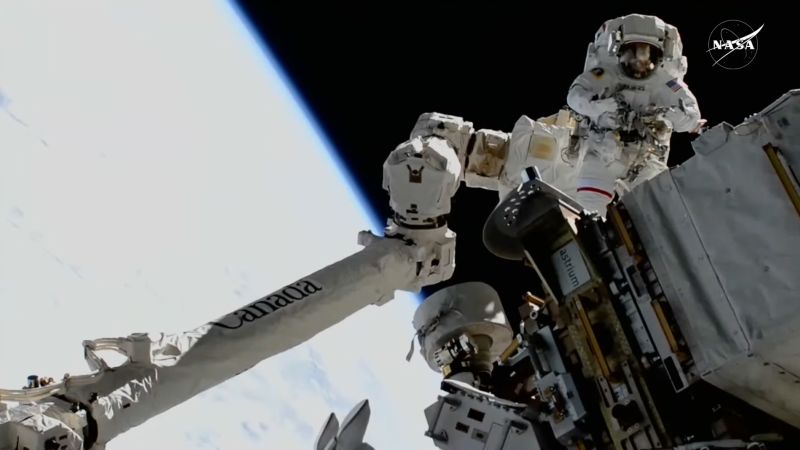Astronauts Suni Williams and Butch Wilmore are currently engaged in an extensive spacewalk, a mission that has stretched into months following their participation in Boeing’s Starliner crewed test flight. On Thursday, they ventured outside the International Space Station (ISS) to perform crucial maintenance tasks, including the removal of outdated radio communications hardware and the collection of samples to explore the potential existence of microorganisms on the spacecraft’s exterior.
The spacewalk commenced at 7:43 a.m. ET and is projected to last approximately six and a half hours. During this time, the entirety of the event is being streamed live on NASA+ and the agency’s YouTube channel. Williams is outfitted in a distinctive white suit marked with red stripes, while Wilmore dons a plain suit as they undertake the 274th spacewalk to maintain and upgrade the station. This particular spacewalk marks Williams’ ninth while Wilmore reaches his fifth.
Throughout the mission, at 11:24 a.m. ET, Williams set a new record by surpassing former astronaut Peggy Whitson’s total spacewalking time, which was 60 hours and 21 minutes. One major accomplishment of the day involved the removal of a critical radio communications component known as the radio frequency group. This S-band antenna had previously resisted removal attempts during two prior spacewalks. Utilizing a specialized wrench tool, both astronauts successfully extracted the hardware, which is set to return to Earth for refurbishment.
As Williams organized the work site post-installation, Wilmore transitioned to swabbing various sections of the ISS for the ISS External Microorganisms experiment. This initiative aims to collect samples from regions near life support system vents, attempting to determine if the station emits any microorganisms into space.
It is significant to note that while all spacecraft and suits that arrive at the ISS undergo rigorous sterilization protocols prior to missions, humans naturally harbor their own variety of microorganisms that regularly regenerate. This raises critical questions regarding which microorganisms might survive the sterilization efforts and make it aboard the ISS. Understanding these microorganisms could have profound implications for future missions, particularly with NASA’s Artemis III efforts aimed at returning humans to the lunar surface and eventually pursuing missions to Mars.
NASA adheres to stringent planetary protection guidelines to prevent contamination of extraterrestrial environments, ensuring that no microbes from the Earth are brought back from other worlds. The ongoing study aims to identify how many microorganisms may escape into space from the ISS, how they cope with the environment, and their potential travel distances.
Interestingly, organisms that have adapted to thrive in extreme environments—such as those found near hydrothermal vents on the ocean floor—are referred to as extremophiles. Researchers hope this experiment will reveal insights into which microorganisms might endure the harsh realities of space including its intense radiation.
Due to time constraints, Wilmore and Williams decided to forgo a lower-priority task of preparing a spare joint for the Canadarm2 robotic arm. This device is crucial for various functions, including moving supplies, equipment, and astronauts around during spacewalks and assisting in the docking maneuvers of visiting spacecraft.
Since their launch back in June aboard Boeing’s Starliner—during its inaugural crewed mission—the duo has had an unexpectedly long assignment, initially aimed at lasting only eight days. Technical difficulties experienced by the Starliner, including helium leaks and propulsion issues, prompted NASA to prioritize astronaut safety by opting not to utilize the capsule for their return back to Earth.
NASA plans for Williams and Wilmore to return on the SpaceX Crew-9 capsule, docked currently at the ISS, no earlier than late March. Their return will follow the arrival of the Crew-10 mission, and by the time they complete their stay in space, they will have been up there for nearly ten months.
In a recent conversation with CNN, former NASA Administrator Bill Nelson elucidated that the decision to prolong Williams and Wilmore’s mission was guided primarily by the safety of the astronauts. This conclusion was reached unanimously by NASA leadership, leading to the decision to fly them home aboard a SpaceX Crew Dragon instead of the originally intended Starship.
While navigating unexpected circumstances, such as those outlined by SpaceX CEO Elon Musk on social media—claiming that the astronauts were “stranded”—it is evident that both Williams and Wilmore have maintained a positive morale. Williams expressed her enthusiasm for the mission and emphasized the importance of their work, ensuring that they do not feel abandoned and are staying productive until it’s time to return home.
In summary, the current spacewalk by astronauts Suni Williams and Butch Wilmore involves essential maintenance and scientific experimentation, impacting both the ISS and future space exploration initiatives. Their extended tenure aboard the station reflects broader implications for astronaut safety and operational logistics within the framework of human spaceflight missions as we look toward returning to the Moon and exploring Mars.



